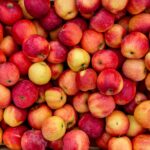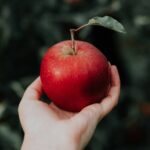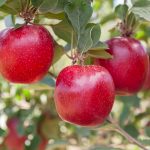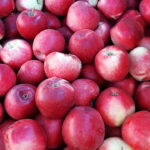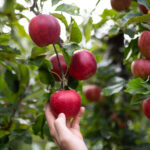Opal apple to enter 'next period of growth' in Europe

Owners of the non-browning, scab-resistant apple have set a goal for volumes to hit at least 1% of the tonnage currently dedicated to Golden Delicious in Europe. 
"In apples you don't normally associate firmness with the yellow color," says Winfried Schuster, quality manager at premium fruit company SanLucar, the exclusive marketer for Opals in Germany and Austria since 2011.
Schuster's comment speaks volumes about the dominant yellow variety Golden Delicious, with anyone entering the category needing to shake up preconceptions connecting the color with mealiness, while also gaining consumer loyalty and providing enough fruit to actually make repeat purchases possible.
"Opal is very sweet and crunchy. It is special because of the taste, the shelf life and also because the flesh is non-browning," he says.
Fruit.select GmbH managing director Michael Weber, one of the owners of the variety 'UEB 32642' which is trademarked as Opal, says negative connotations linked to Golden Delicious have made developing Opals a kind of "mission impossible" project.
"It's a long journey to get a yellow apple on board and there are a lot of negative associations or experiences with mealy golden apples," Weber says.
"But in the end it’s a work in progress and we believe two things are important today – on the one hand we need to control production with our partners and not over-plant. We need to get feedback from the market on consumer demand," he says.
"The second thing is brand positioning and to tell the consumer why we are doing it." 
This is one of the reasons Weber is working with SanLucar for developing the brand in German-speaking markets, in addition to slightly more established but still developing footholds in other European countries like the U.K. and France.
"We believe SanLucar are a super partner for the Opal project because their philosophy matches the flavor.
"SanLucar are renowned for flavor and our apple is flavorsome so we matched up together. In 2015 we moved on to Spain to start production in Catalonia and Aragon, and then in 2016 in Italy," he says.
"It's an ongoing journey and today we have planted one million trees which is about 330 hectares."
European production and marketing outlook
France and the U.K. are currently the leading sources of supply but they will more than likely be overtaken by Italy and Spain in the years ahead. Most trees are young though, and the best case volume scenario for Opals in 2018 would be to reach volumes above 3,500 metric tons (MT), provided there are no weather disasters between now and the harvest.
This volume would represent less than 0.2% of the annual production figure for Golden Delicious.
"There are about two million tons of Golden Delicious production in Europe - 1% of that golden market in Europe is our target, and that would mean we’d have a surface area of around 600 hectares and 25,000MT," says Weber.
"I think we are moving into the next period where we are coming from a top-down approach of making sure there's demand in the market from the pull side, to the point now where we have identified the best growing regions and we're getting into a push role and we expect some significant plantings over the next three to five years."
For this push stage to work, Schuster emphasizes the importance of collaborative grower partnerships.
"We have to learn from the grower side, to be in touch with them day by day during the harvest time and to learn about apples," he says.
"The apple market at the moment is one of the most fast-changing markets in the food business because of new varieties. Every one of the big chains likes to have their own varieties.
"It's very interesting not only to find the right variety for the customers but also the right variety for the growers. We have to be in contact with the whole supply chain, from the nurseries to the growers to the supermarket."
This direct, top-down approach with retailers was taken in the earliest days of Opal in Europe through Empire World Trade, now part of Belgium-based multinational Greenyard.
"I think the story is quite nice in the United Kingdom and Germany because they each have large populations of between 60-85 million and Golden Delicious has a very low reputation in both countries," says Weber.
"In England almost 100% of this color category is imported, so we are quite happy that we have some 'Buy British' domestic consumption for a yellow-colored apple."
Star Fruits chair Philippe Toulemonde handles the variety in France, where development has been somewhat different due to the plethora of established cultivars competing head on with Opal.
"Golden is a big part of the range of apple varieties and the quality of golden is quite low. Moreover we have competition with other yellow apples like Tentation and GoldRush, so you have a lack of demand for this product at this time," Toulemonde says.
"The market is more focused on bi-colored varieties than yellow varieties...but where we have developed Opal is on the eating quality and scab resistance, in both organic and conventional, and it's been through business-to-business sales."
Star Fruits is also the license manager in Europe for the renowned apple brand Pink Lady. We ask Toulemonde whether Opal could become the Pink Lady of the golden category.
"I think we don’t have to copy the Pink Lady system, which was known even before the trees were planted," he replies.
"With UEB 32642 perhaps as a variety it’s more about techniques and we need to choose the good soil to produce. Moreover, we were lucky with Pink Lady because this was a new segmentation in the pink apple.
"But with Opal we are with the golden apples and we have to make a difference. We have an advantage in this sense because the situations and opportunities are different to Pink Lady - the story of Opal is interesting because it's rustic, authentic and good-eating and we have to focus on this point."
The more golden cultivars the better
Another golden apple that has come on the scene in recent years is Yello, a brand developed by grower cooperative organizations VOG and VI.P from the Japanese-bred variety Shinano Gold. The apple's cultivation expansion was limited this season due to frosts, but commercial trials were undertaken in Italy and other parts of Europe.
We ask Weber for his thoughts on the introduction.
"Generally speaking we think it’s a good thing. Do you know why? Because in the golden section, with Tentation and GoldRush there was already a history to challenge Golden Delicious since 20 years ago," he says.
"But there was not an apple that so far has had a real impact on a European scale.
"We are not getting scared of one or two more yellow varieties that will be developed over time because the market for Golden Delicious is huge. In Italy, 50% of all apples eaten are Golden Delicious.
He emphasizes that in fact the amount of variety introductions in yellow apples is considerably low compared to the influx of new bi-colored varieties hitting the market each year.
"Retailers want to have a very attractive display of fruit and vegetables, and they want value-added yellow/gold apples in the sea of red, pink ones, and grannys. Just for the eyes they need them," Weber notes.
"The Opal apple comes from a disease-tolerant tree so in some areas we can reduce significantly our spray treatments.
"And it's a non-browning apple. We don’t need any genetic modification – it’s naturally non-browning," he says.

















